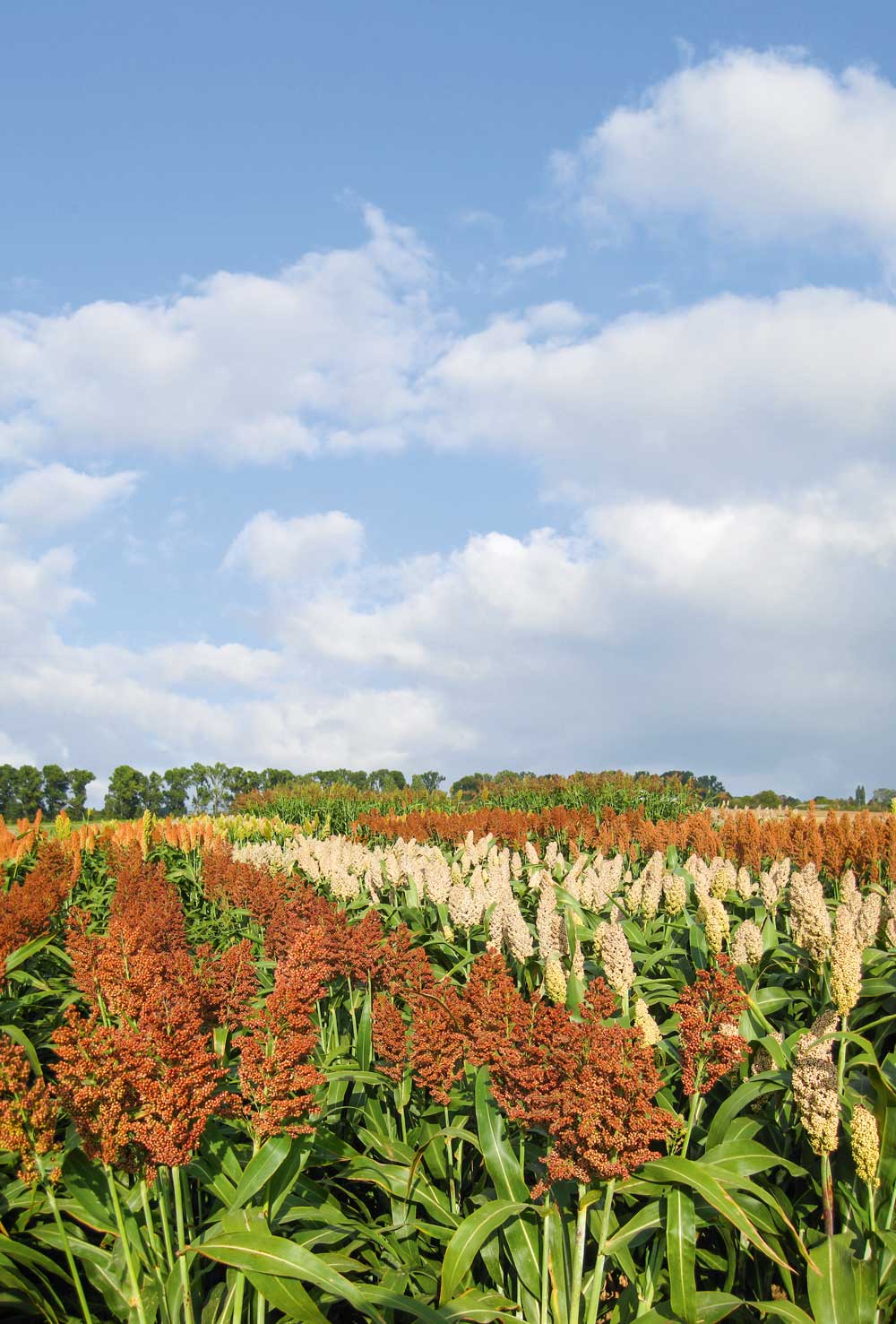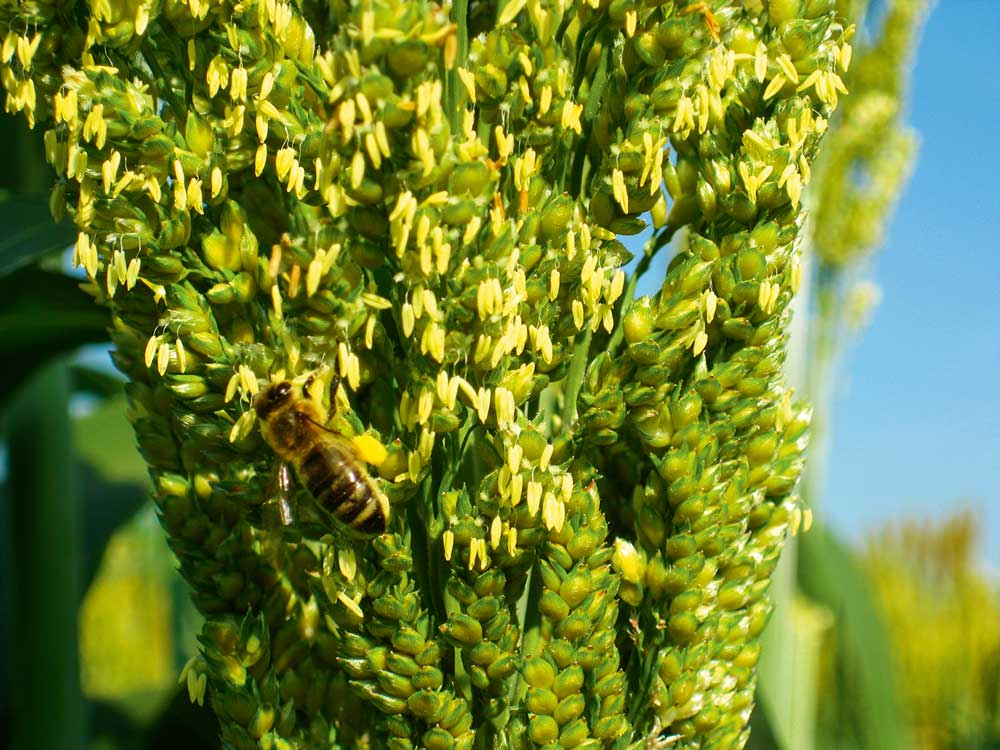Sorghum millet: Underestimated crop
By Dr Steffen Windpassinger and Dr Benjamin Wittkop, University of Giessen, Dr Kerstin Jäkel LfULG, Nossen, Dr Reinhold Siede LLH, Kirchhain
Like maize, sorghum is a C4 plant. These can achieve high biomass growth in warm and radiant weather. Sorghum's exceptional drought tolerance is based on waxy leaves and a root system that reaches up to 2 m deep, which also enables good nutrient efficiency. Sorghum has a high adaptation potential to a wide range of site and climate conditions. Therefore, a significant part of the global production is now produced in temperate regions of the USA and Argentina. In Europe, cultivation is (still) of relatively minor importance, but in 2020, the area under cultivation increased by 19% compared to the previous year.
Types of use and their potential in Central Europe
Due to early selections during the spread on all continents, sorghum has developed a high diversity of utilisation types. Grain use plays the most important role worldwide. In western countries (Europe, USA, Mexico, Argentina, Australia), sorghum is mainly used for animal feed, export and partly also for bioethanol, while in Africa and India it is a staple food.
There are variety-specific differences in grain colour (white, yellow, brown, wine-red, black) and tannin content. For animal feed, mainly tannin-free varieties are used, as they allow a higher feed conversion efficiency in chicken and pig fattening that is at least equivalent to maize. In human nutrition, on the other hand, the polyphenolic tannins can be beneficial, providing antioxidant effects and reduced calorie intake. Sorghum grains are gluten-free, which, together with the positive health aspects mentioned, could lead to an increase in importance for human nutrition in western countries as well in the future.
Varieties optimised for combine threshing ("grain sorghum") are sturdy and small (max. 1.60 m). Practical yields for grain sorghum in France and Italy are on average about 5 and 7 t/ha, respectively. However, it must be taken into account that, in contrast to maize, sorghum is often grown on dry sites with little or no irrigation. Under favourable conditions, much higher yields can be realised. For example, experience from Austria, where grain sorghum is cultivated on about 7,500 ha in suitable locations, shows that practical yields of up to 13 t/ha are quite possible.
Dual types as an alternative to maize
Due to their plant architecture and material composition, so-called dual types are an alternative to silage maize. They are approx. 1.80 to 2.50 m tall and can achieve starch contents comparable to silage maize due to a high proportion of grain in the total dry matter.
For some time now, the University of Giessen has been working in cooperation with breeders on the development of adapted dual types with improved stress tolerance, maturity and energy density. Currently, three candidates are in the process of applying for plant variety protection in Germany. Two of them are expected to be available on the market from 2021. In a project funded by the Agency for Renewable Resources (Fachagentur für Nachwachsende Rohstoffe e.V.), these three dual-type variety candidates were tested in 2019 together with two sorghum biomass types, two Sudan grass hybrids and two silage maize varieties at six locations in Germany.
The yield level of the individual locations differed greatly. The high-yield sites Straubing (Lower Bavaria) and Poppenburg (Southern Lower Saxony) contrasted with sites in Eastern Germany, including the recultivation site Welzow, which were more affected by drought. Looking at the mean value across all locations, the sorghum biomass types achieved the highest yields and clearly outperformed maize. The sorghum dual types achieved yields at maize level, while the Sudan grass hybrids remained slightly below. An individual analysis of the locations shows that maize in Straubing achieved the best yield in absolute and relative terms. In contrast, sorghum was clearly superior to maize at the other high-yielding site, Poppenburg. This refutes the widespread view that sorghum cultivation is only worthwhile on low-yield sites. Nevertheless, the relative yield advantage of sorghum was highest at the extreme location Welzow.
Use sorghum not only as a biogas substrate!
In the course of climate change, the importance of sorghum in Germany and Central Europe is likely to increase and go beyond its current use as a biogas substrate. Thanks to their material composition, the dual types also represent an alternative to silage maize in cattle feed.
Cultivation for grain use could become an alternative to grain maize or spring cereals in suitable regions. Yields of 10 t/ha are feasible. From a farm management point of view, sorghum can contribute to an equalisation of labour peaks on farms with a high maize share, as sowing takes place after maize and there is greater flexibility with regard to the silo harvest date than with maize. This is because the leaf apparatus of sorghum remains green even during severe drought and is therefore suitable for silage. Sorghum cultivation does not require any new investments: Silage harvesting with dual types can easily be done with a maize chopper, while grain sorghum can be harvested with conventional grain combines. The sowing of both types of use can be done in single grain placement or as drill sowing (grain technology).
Agro-ecological advantages of sorghum
Besides its good drought tolerance and nutrient efficiency, sorghum has numerous other agro-ecological advantages. As a summer crop, it can be integrated in many ways into existing systems and, in crop rotations dominated by winter cereals, it can make an important contribution to the control of problem grasses (e.g. field foxtail). Especially on marginal sites, sorghum can contribute to soil improvement thanks to its positive humus-reproduction performance, which is comparable to that of legumes. In addition, the plant protection requirement (treatment index) of sorghum is very low. It is not a host plant for the western corn rootworm and is also only slightly infested by the European corn borer. Only herbicide treatment may be required during juvenile development. However, weed control can also be carried out mechanically if the row width is suitable, which makes sorghum also suitable for organic farming.
Sorghum as bee feed
Particularly noteworthy is the agro-ecological value as bee food. Depending on the location, type of use and variety-specific maturity, sorghum flowers in the period from the end of July to the end of August, which is characterised by a critical gap in grape pollination. Investigations by the Kirchhain Bee Institute, Germany, as part of the joint project (SoNaBi) funded by the Agency for Renewable Resources showed that free-flying bee colonies collect sorghum pollen in a targeted manner and that this is a component of a complete protein diet for honey bees. Results from flight tent experiments also showed that sorghum pollen is used by bees for brood rearing. Physiological studies on individual bees also show sorghum pollen to be a suitable bee food, comparable in quality to the pollen sources widely used in Central Europe. However, the prerequisite for these positive effects of sorghum cultivation is a sufficiently strong and stress-tolerant pollen shed.
Breeding goals for sorghum
Besides yield and agronomic traits, the improvement of cold tolerance is a major breeding objective for Central Europe. Improving cold tolerance in the early juvenile stage would allow earlier sowing times comparable to maize and thus higher yield potential as well as better maturity. Sorghum can also be sensitive to unfavourable weather conditions (cool temperatures, lack of sunlight) before or during flowering, which can have a strong negative impact on pollen fertility and thus grain yield. Improving reproductive cold tolerance was another focus of the SoNaBi joint project. In cooperation with the two breeders' houses, the University of Gießen developed new breeding material that forms a complete grain set even at night temperatures of below 10 °C. The new breeding material is also suitable for the cultivation in the winter.
Conclusion
The history of maize shows that an originally tropical plant can be successfully established in Central Europe. The same success story is possible for sorghum. However, despite modern breeding methods, improving quantitative traits such as cold tolerance still takes time and investment on the part of the breeding community. The development of adapted, improved varieties must therefore go hand in hand with the establishment of sales opportunities and value chains for sorghum. Only in this way can it move in the foreseeable future from being a "plant of the future" to a real and large-scale alternative in Central European agriculture. Especially under the changing climatic and political conditions, sorghum is actually indispensable thanks to its drought tolerance and low production intensity.




